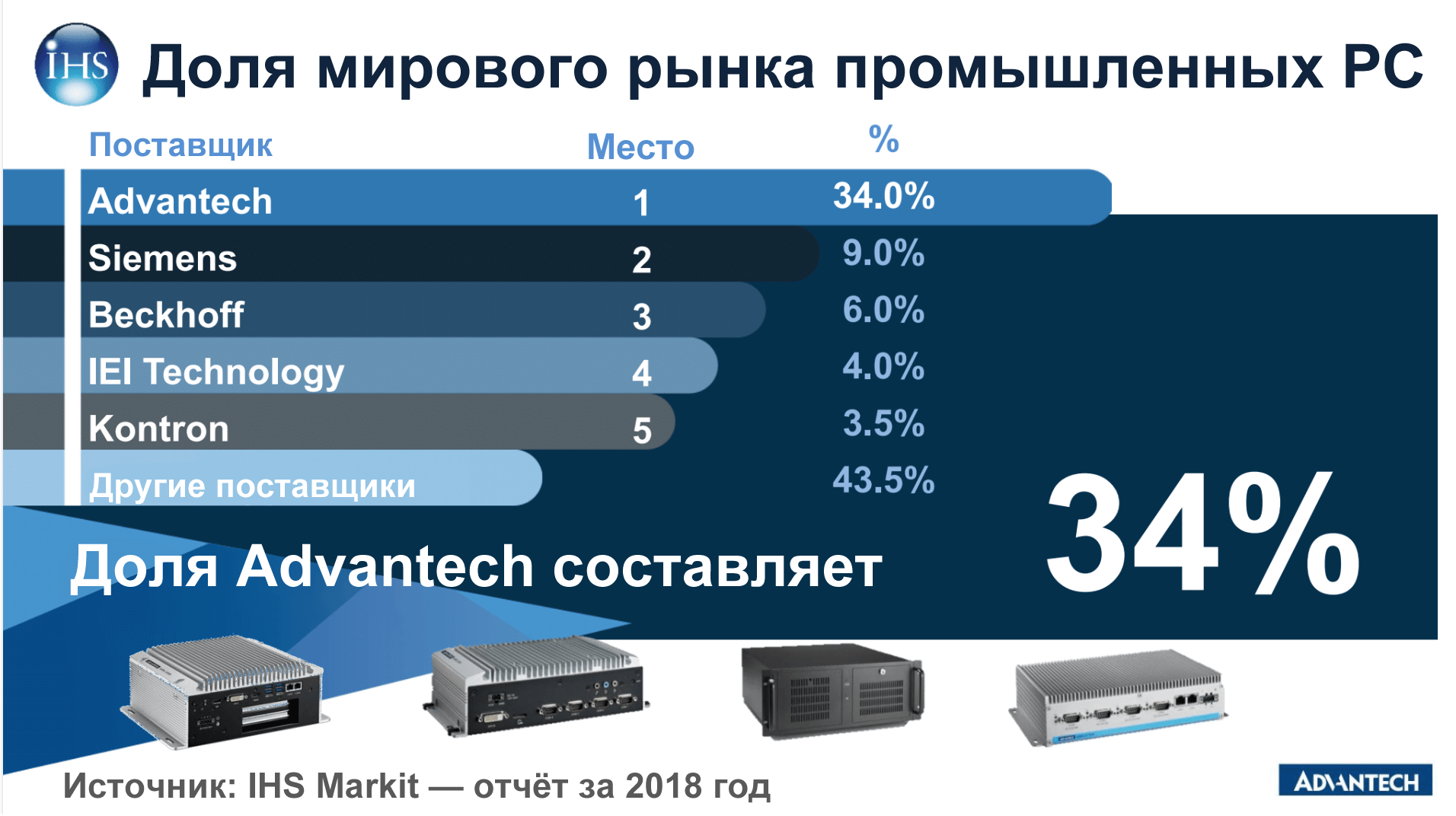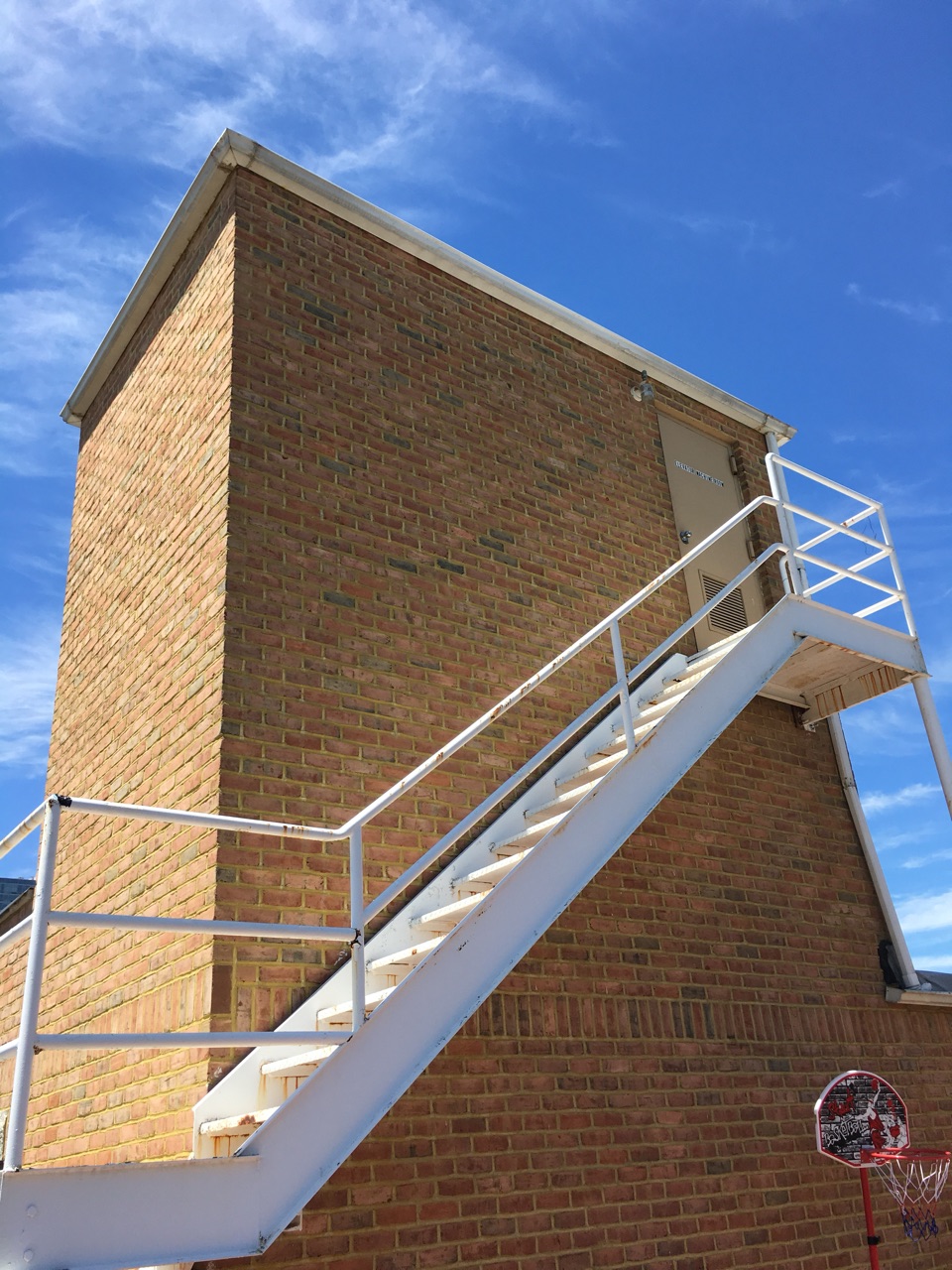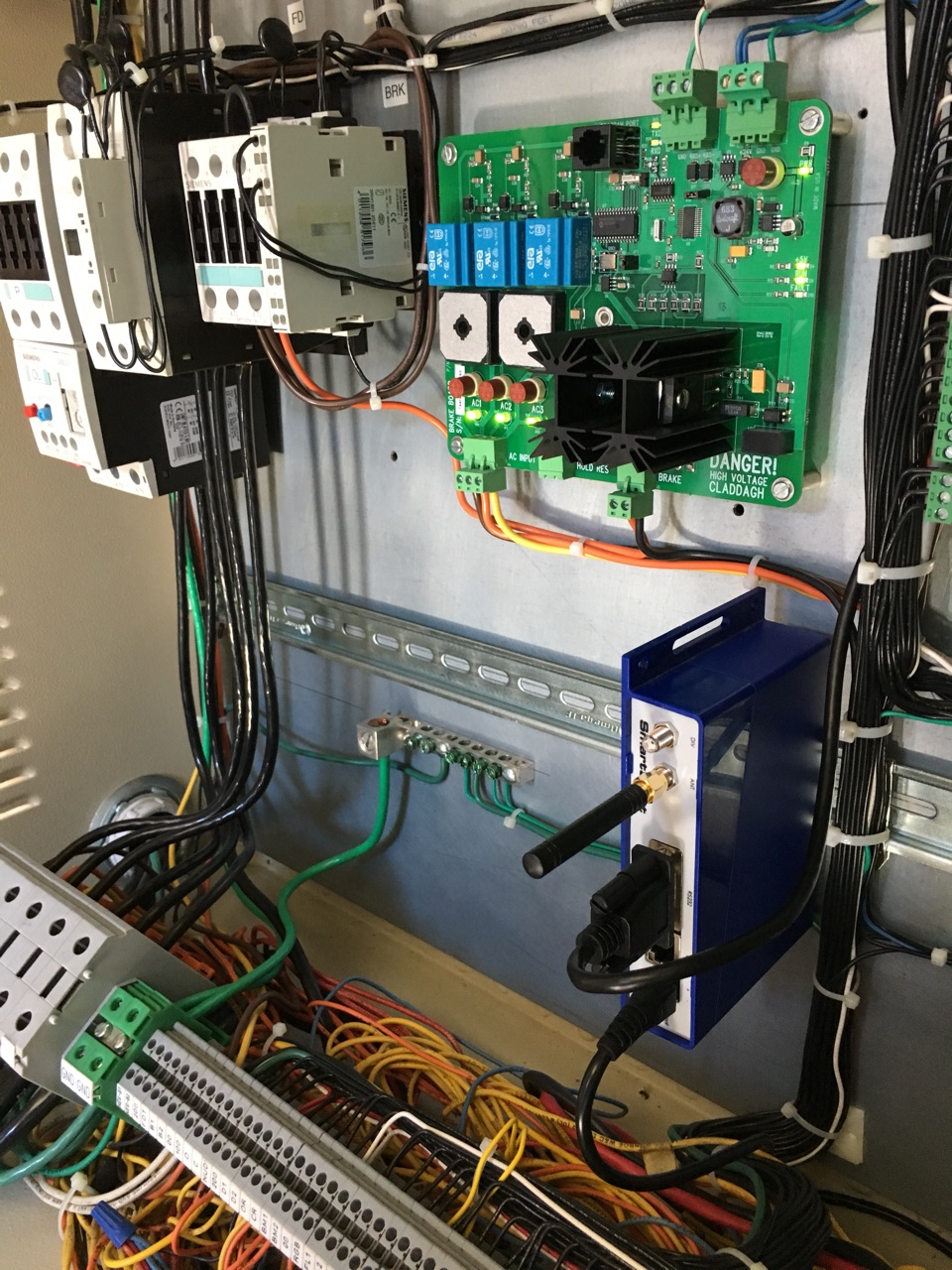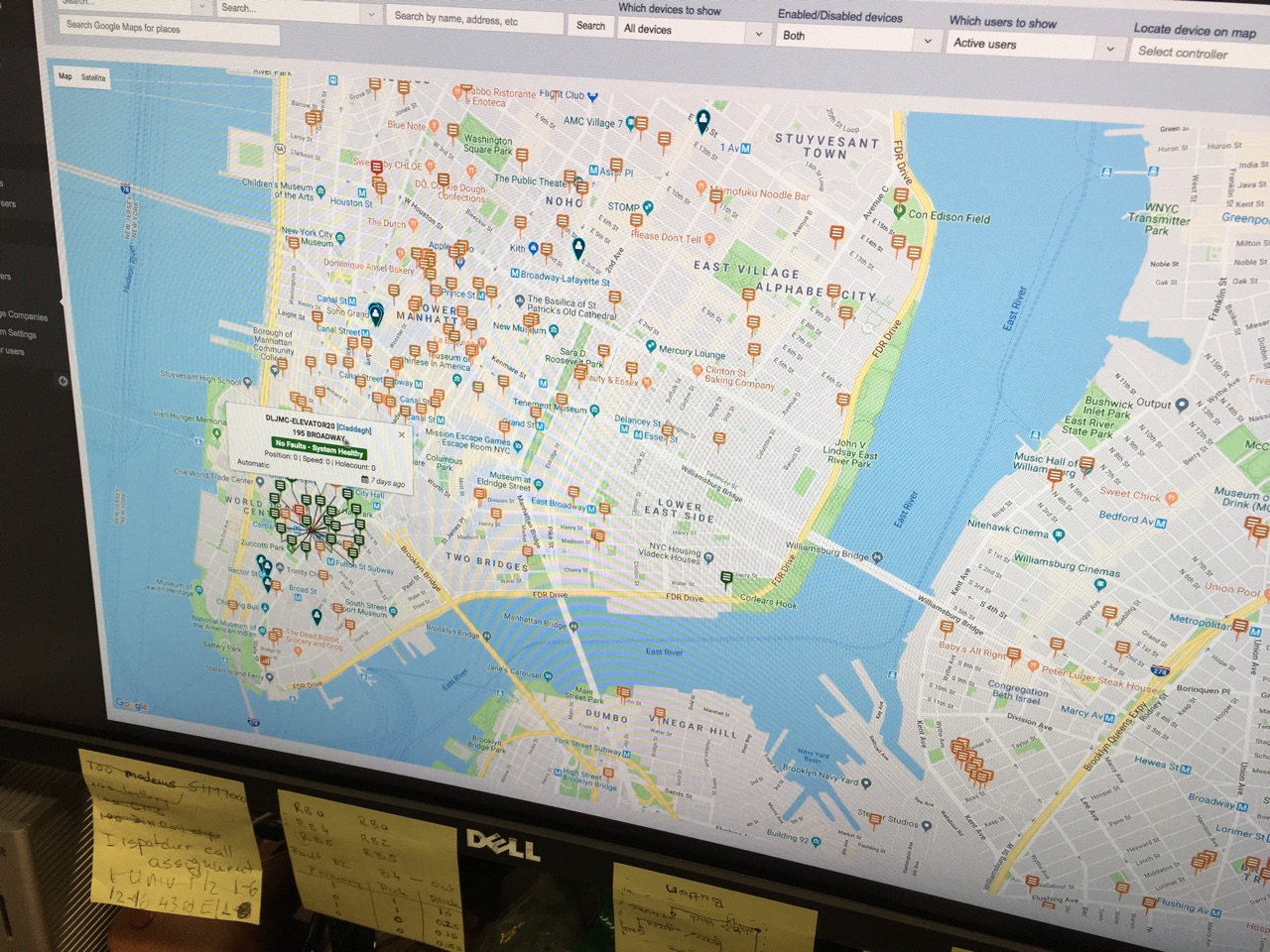Hi, Habr, we are Advantech

We are glad to introduce ourselves, we are Advantech , a manufacturer of a huge number of solutions for automation, industry, health care, retail and telecommunications, headquartered in Taiwan. Our products are used worldwide, including in systems of federal scale in Russia.
At the end of 2018, we launched a full-fledged representatively Advantech in Moscow, and are now ready to communicate directly with a professional Russian-speaking audience. In the next two years, we are planning to launch a vocational training center to train specialists ready to solve problems in the field of intellectual production, electric power industry, logistics, networks and information security. We will be happy to find employees, customers and partners on Habré.
')
In our blog, we will tell how our products help solve a variety of tasks, from oil production to greenhouse automation. Show how modern production is organized in the framework of the Industrial IoT concept, industrial protocols and software, as well as arrange independent crash tests of our protected devices.
We will encourage developers to study modern industrial technologies with the help of hackathons and CTF . We will make every effort to make our publications interesting and useful to a wide range of IT specialists.
Under the cut a brief history of the company, a description of the main activities, and several success stories of our customers.
Advantech Company History
 The company was founded in 1983 by three former engineers of Hewlett-Packard, and began its development with the production of industrial automatic testing devices. In 1985, the company is transformed into a joint stock company and continues to produce various PC boards for testing. In 1987, the company decides to move from the field of system integration and custom development, starts its own production and enters the external market. At the end of the year, Advantech’s first overseas office in the USA (San Jose, California) appears. By the end of 1988, successful sales began in Europe and Asia. In 1989, Advantech buys a factory in Xindian, Taiwan, and begins developing its own line of industrial computers (IPC).
The company was founded in 1983 by three former engineers of Hewlett-Packard, and began its development with the production of industrial automatic testing devices. In 1985, the company is transformed into a joint stock company and continues to produce various PC boards for testing. In 1987, the company decides to move from the field of system integration and custom development, starts its own production and enters the external market. At the end of the year, Advantech’s first overseas office in the USA (San Jose, California) appears. By the end of 1988, successful sales began in Europe and Asia. In 1989, Advantech buys a factory in Xindian, Taiwan, and begins developing its own line of industrial computers (IPC). In 1990, the company launched its first industrial computer, the IPC-600. The design of the chassis was so successful that on its basis the IPC-610 models are still being produced. In 1992, the ADAM-4000 devices were released, which were a real breakthrough in remote control and data collection systems.
In 1990, the company launched its first industrial computer, the IPC-600. The design of the chassis was so successful that on its basis the IPC-610 models are still being produced. In 1992, the ADAM-4000 devices were released, which were a real breakthrough in remote control and data collection systems.In 1999, a successful IPO. From this point forward, Advantech shares are traded on the Taiwan Stock Exchange (TPE: 2395). In 2001, the construction of the Advantech Neihu building in the city of Taipei was completed, to which the head office of Advantech is still located. In 2003, the European company AEU (Advantech Europe BV) was launched, as well as the launch of the Kunshan Manufacturing Center in China. At this point, Advantech is in the top 10 brands in Taiwan according to Interbrand agency.

Advantech headquarters building in Taipei
For ten years, the company has become a world leader in the production of industrial computers, while expanding its activities, including through the acquisition of promising companies such as: Czech manufacturer of telecommunications equipment B + B SmartWorx, Inc., manufacturer of systems for gaming machines Innocore Gaming Ltd., and others.
Advantech today
Now Advantech is a large corporation, with various business lines and industries in Taiwan, China and the Czech Republic. Our offices are in China, Japan, Korea, Europe, USA, Southeast Asia, Australia and Russia.
Advantech - No. 1 in the world in terms of industrial computer production (IPC) - about 30% of the global share. The company is constantly developing and expanding areas of activity, including through the acquisition of promising companies.

Advantech ranks first in the world in the production of industrial computers.
Product Categories
All Advantech products are divided into three large groups by directions. Each group has its own development, production, and marketing centers, and from the inside they look like separate companies. Each group has its own color, it can be seen in the catalogs and on the website, in the product description.
Industrial IoT
formerly Industrial Automation Group
This department manages industrial controllers, data acquisition modules, fanless and rack-mounted computers, visualization tools, equipment for industrial communications.
Embedded IoT
previously Embedded Computing Group
The main spectrum - single-board computers, systems on the module, high-performance servers, equipment for the main telecom.
Service IoT
Previously Applied Computing Group or iService
The four main areas - medicine, computers for logistics (DloG), equipment for retail (AdvanPOS) and wearable devices.
Previously, the fourth department was identified - Intelligent Systems Group (ATX and PICMG components and ready-made systems, the color of the catalogs is blue). At present, the department has been liquidated, the products have been transferred to the IIoT for the most part, to the EIoT to a lesser extent.
Success stories
Over the years we have gained experience in implementing hundreds of successful projects in different countries. Some of them are published on the website advantech.ru/success-stories .
The system of automatic collection of transport payments
Partner: Corson Technologies Rus
The system of automatic charging for trucks was built on the order of the Ministry of Transport of the Russian Federation and put into operation in 2015. The tasks of the system include tracking the movement of vehicles throughout the entire journey using video cameras, RFID and laser readers. Accounting of cars is carried out when driving through a special frame with sensors, equipped above the road. By the end of 2017, about 500 such frames were installed.

Frame with installed sensors and cameras
To build the system, the integrator chose Advantech industrial managed switches ( EKI-7428G-4CI & EKI-7720G-4FI ) and fanless industrial computers ( AIIS-5410P ), designed for video surveillance systems and specially customized for this project. The AIIS series computers have built-in Ethernet ports with PoE, which allows you to connect IP cameras directly to the computer, without using intermediate PoE injectors or separate switches.
Several Linux containers are running on the same computer for different tasks: vehicle number recognition, sensor data processing, etc.
All processed data is transmitted to the data center over the network. The network subsystem was subject to high demands for reliability and speed of recovery in the event of a communication break. Advantech X-Ring Pro proprietary technology is used to reserve channels: all the switches are combined into a “ring” topology, and in the event of an ethernet line breaking, the system switches to the backup direction in 20ms.

Schematic representation of the components of the accounting system of cars
Monitoring lift systems
CloudMonitoring provides solutions for monitoring industrial sites. One of their clients, a New York elevator systems integrator, needed a solution to collect data from a remote elevator control system ( REMS ).

Elevator mine in New York
It was decided to use a 4G (LTE) network. The task was complicated by the fact that the panel board was located in elevator mines, where the signal level of the cellular network may be low. Equipment was required to support MQTT and Python, as well as the ability to transmit the last message even in the event of a complete power failure.
The Advantech ICR-3211B LTE router, with support for LTE Cat.M1 and backward compatibility with GSM, was chosen as a communication gateway. LTE Cat.M1 protocol was specifically designed for M2M solutions, has a low data transfer rate (375 kb / s), as well as a longer range and increased stability in difficult indoor communication conditions. The router has a built-in large-capacity capacitor, the charge of which is enough to send a message in case of a complete power failure.

Elevator communication cabinet with router ICR-3211B
At the moment, the system is actively being actively used, allowing dispatchers to see a complete picture of the status of all nodes of each elevator, receive notifications in case of an accident, and see the latest system status after the power is turned off.

Interface of the monitoring system CloudMonitoring
Source: https://habr.com/ru/post/445912/
All Articles